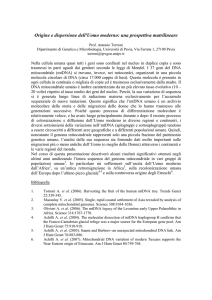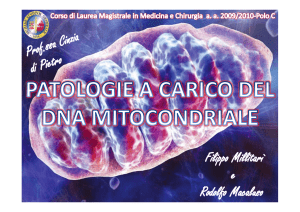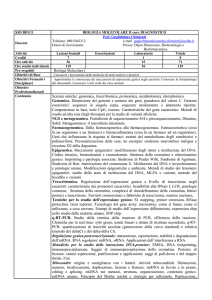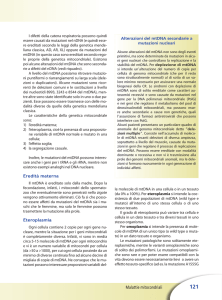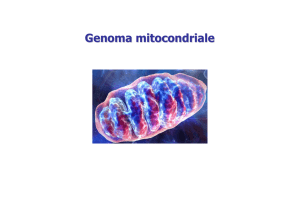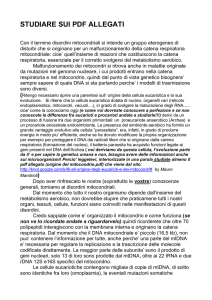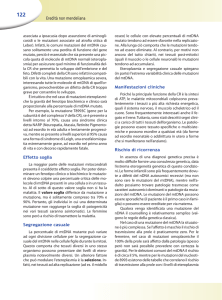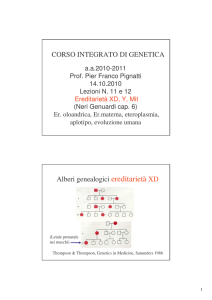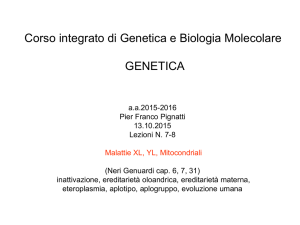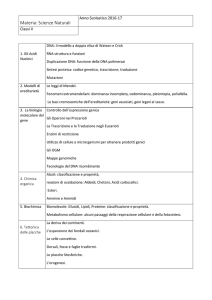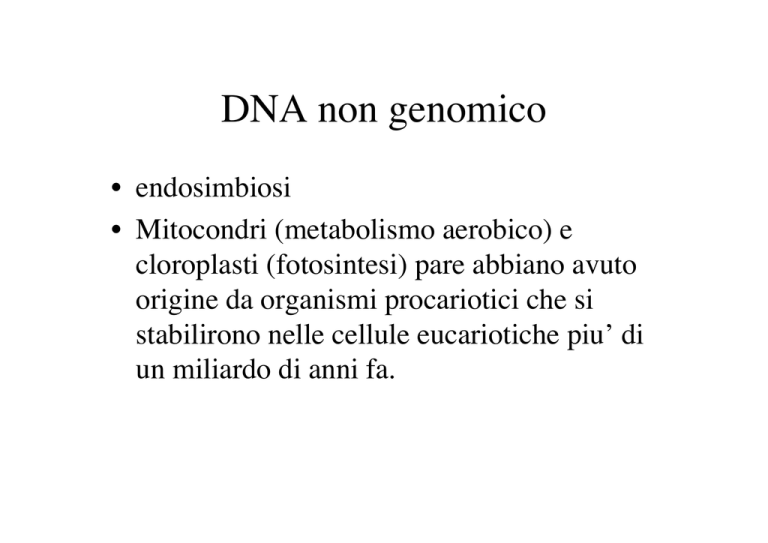
DNA non genomico
• endosimbiosi
• Mitocondri (metabolismo aerobico) e
cloroplasti (fotosintesi) pare abbiano avuto
origine da organismi procariotici che si
stabilirono nelle cellule eucariotiche piu’ di
un miliardo di anni fa.
Dna non genomico: eredita’ non mendeliana
Cloroplasti: eredita’ non mendeliana sia della cellula che
dell’organismo.
eteroplasmia
In molte piante, ma non in tutte, i cloroplasti sono portati solo dal
gamete femminile quindi l’eredita’ e’ materna.
Correns
DNA mitocondriale
Giallo: mtDNA
Rosso: nuclear DNA
Generali sul DNA mitocondriale
(Snustad cap 19)
•Scoperto negli anni 60 (EM, poi analisi fisiche e biochimiche)
•Dimensioni variabili nei diversi organismi: da 2500 kb a 16-17kb
•Ogni mitocondrio ha piu’ copie (ovocita di vertebrato 10e8!),
cellule somatiche circa 1000
•Generalmente circolare tranne alcune specie (lineare in
Chlamidomonas reinharditii e nel ciliato Paramecium aurelia)
•Le molecole circolari hanno varia organizzazione:
-vertebrati (uomo) 37 geni in 16-17kb.
-in alcune piante (DNA piu’ grande)geni dispersi e introni
•Il mitocondrio ha sua macchina per esprimere mt genes
mtDNA negli invertebrati
mtDNA lievito:
Circolare
78 kb
Almeno 33 geni per rRNA
23-25 geni per tRNA
1 gene per proteina ribosomale
7 geni per proteine della fosforilazione ossidativa
geni con introni
sequenze intrageniche
mtDNA negli invertebrati
mtDNA piante vascolari:
mais 570 kb
melone 300 kb
molte sequenze non codificanti, introni,
duplicazioni
Ricombinazione intramolecolare del mtDNA nel cavolo cinese
mtDNA piante: peculiarita’
• Editing dei trascritti: C -> U
(anche nei mt dei tripanosomi)
• Trans-splicing (e.g.
NADH reduttasi)
Human mtDNA
16.559 bp
Lettura dei due
filamenti (H ed L)
Trascritto policistronico
37 geni, no introni:
-2 per rRNA
-22 per tRNA
-13 per proteine della
fosforilazione ossidativa
Simile nei topi nei
bovini e nelle rane
Human mtDNA
Differenza nella
lettura del codice:
AGA: terminazione
AGG: terminazione
UGA: triptofano
(invece di
terminazione)
AUA: metionina di
inizio
Evoluzione separata: i mitocondri sarebbero organismi viventi liberi incorporati
nelle cells euc. piu’ di un miliardo di anni fa
MITOCONDRIAL DNA AND HUMAN DISEASE
•Alcune malattie sono legate al mtDNA:
-neuropatia ottica ereditaria (LHON-cecita’ negli adulti).
Mutazione di uno qualsiasi dei geni mitocondirali. Eredita’
materna.
-sindrome midollo-pancreas di Pearson (perdita delle cells del
midollo osseo durante l’infanzia). Perdita di una grossa
porzione di mtDNA. Acquisita.Eteroplasmia mitocondriale
•1/3500 people have or at risk of mt disease
+associated diseases
• NB: some mt disease can arise also from nuclear mutations
•First described 1988
To understand mt-disease one has to think of mt-metabolism
NADH
FADH
Complessi
coinvolti nella
fosforilazione
ossidativa che
porta alla
produzione di
ATP
An mt-related disease can be distinguished from a nuclear diseasedifferences of inheritance
Other pecularities of mt-DNAgenetics and related diseases
•Concept of threshold in mt disease:
heteroplasmy and (apparent) homoplasmy
•High mutation rate
•Studies challenge maternal inheritance, but very rare
(interspecies data, muscle mtDNA)
•Nuclear-mt interactions can change the phenotype (eg
LHON from homoplasmic mother in 10% of females)
•4% phenotype inheritance from an affected mother
mt-disease inheritance: bottleneck in heteroplasmic case
Given the central role of mithocondria many different mtdiseases
How to understand whether a disease is linked to mt-DNA?
mtDNA sequencing even if not conclusive
unless for well known syndromes
mt-related clinical syndromes
Functional or structural genes can be implicated in mtsyndrome
Models for studying mt-diseases: cybrid cells, transgenics
cell line
Allotopic expression of
mt genes
mt depleted
Mut mtDNA in
zygotes:heteroplasmy
Patient mt reintegrated
(selection)
cybrid
Mut mtDNA in zygotes:heteroplasmy
Differenze nei diversi animali e tessuti
Cybrid cytoplast in the zygote
Nature Genetics 2000 Inoue et al
Cox expression in mt-mutant mice
a,b soleus muscle
c,d cardiac muscle
e mice anemya
f normal and mutated
kidney
a-c normal
b-d-e mutant
mtDNA a renal failure
Nature Genetics 2000 Inoue et al
For animal models and avoid human mut-mt-DNA transmission:
selection and “use” od wt mtDNA
Involvment of mtDNA in common (disease) phenotype/
predisposition: diabetes, parkinson, alzheimer, IQ (?)
cerebellum
Skeletal
muscle
Colonic
crypt
Caridac
tissue
Extraocular
muscle
ageing and mt-defect: heteroplasmy of Cox
Blue: cox-deficient
Nature 2001
Curiosity
Exercise increases satellite cell number
which contain a low or negligible
amount of mutated mtDNA…
Correlation between mt mutations and
cancer: cause or consequence?
Human genome/animal cytoplasm
To produce chimeric embryos for
stem cell production
Importanza dei mitocondri?
TECNOLOGIA & SCIENZA
Invia
Stampa
Permessa la creazione degli "embrioni-chimera" a scopo di ricerca
Produrranno cellule staminali da usare per cercare cure a molte malattie
Gran Bretagna, via libera a embrioni ibridi
Al loro interno Dna umano e animale
Il Vaticano: "Un atto mostruoso contro la dignità umana”
Repubblica.it settembre 2007
MT DNA AND HUMAN EVOLUTION
• evolve piu’ velocemente del DNA nucleare: 0.017 x10e-6 mut/site/year
(eukaryotes is in generally 10-4 to 10-6/gene/generation)
•trasmesso solo per via materna (not in Drosophila and mice): dogma in
humans? mtDNA of paternal origin is destroyed in oocytes by
ubuquitination
•abbondanza del campione (1000 copie, extranuclear).
Doubt: which is the population to be considered?
Problem: heteroplasmy?
•no ricombinazione
Doubts? Recombination possible. Mithocondria have functional
recombinase. But no mix of genomes (male/female) -> not so important
Studi pionieristici : anni ‘80 Allan Wilson, Rebecca Cann, Mark
Stokening
What is studied
•RFLP
•Sequence of fragments
•Sequence of hyper-variable regions
•Sequence of whole mt DNA
Population or lineage (haplotype) studies
What have we learned
•Most important finding sull’ uomo moderno:
african origin, 120,000-150,000 anni fa
•No Neanderthal contribution 1997
•migrations
No Neanderthal contribution 1997
Differenza in 28/379 nucleotidi sequenziati
Uomo moderno e neanderthal cominciarono a evolversi
separatamente a partire da 550.000-690.000 anni fa. I
neanderthal poi si sono estinti
Median joining network based on mtDNA hyper-v.
region1 sequencing of 6 eurasian populations
Multidimensional scaling plot based on genetic distances
of 6 eurasian populations
human populations: migrations
Oldest groups
Open problems in mtDNA-based evolution studies
•Only maternal origin
•Single locus
•Statistics
•Uncorrect databases
•Nuclear inserts in mtDNA (numts)
•Unidentified selective pressure
Need to be complemented ideally with data on Y and
on autosomes
Other use of mtDNA
-Forensic applications of mtDNA:
some problems are common to evolutionary studies, but
importance of sample availability
- Personalized genetic history:
individual genealogies
companies
An ethical question
Nature 439, 126-127 (12 January 2006
DNA tests put death penalty under fire
Emma Marris, Washington DC
Campaigners hope re-examination of evidence will
undermine capital punishment.
US campaigners against capital punishment are hoping that
modern DNA tests in old cases will undermine public
confidence in the death penalty.
In the next few weeks, genetic testing of an old sample
could show that Roger Keith Coleman — executed in 1992
for rape and murder — was not guilty. The tests are being
conducted at Canada's Centre of Forensic Sciences in
Toronto, and were requested by the state of Virginia's
governor, Mark Warner. If Coleman is exonerated, it will be
the first time that genetic evidence is used to prove that
the US death penalty has killed an innocent person.
Monday, Apr. 19, 1999
Roots
Mania
By Margot Hornblower
America’s latest obsession….
Where to go to get your genetic history
Tree: evolutionary relationships among principal human
population groups
Not just a mania…
•Sociopolitical interests
•forensic
•Medical purposes….

